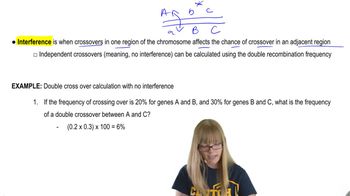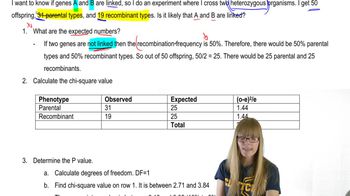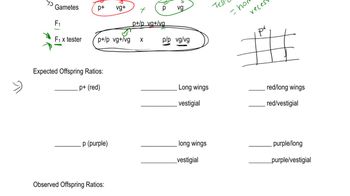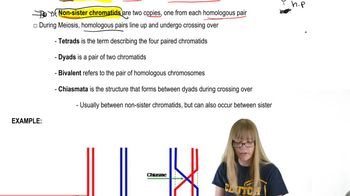Table of contents
- 1. Introduction to Genetics51m
- 2. Mendel's Laws of Inheritance3h 37m
- 3. Extensions to Mendelian Inheritance2h 41m
- 4. Genetic Mapping and Linkage2h 28m
- 5. Genetics of Bacteria and Viruses1h 21m
- 6. Chromosomal Variation1h 48m
- 7. DNA and Chromosome Structure56m
- 8. DNA Replication1h 10m
- 9. Mitosis and Meiosis1h 34m
- 10. Transcription1h 0m
- 11. Translation58m
- 12. Gene Regulation in Prokaryotes1h 19m
- 13. Gene Regulation in Eukaryotes44m
- 14. Genetic Control of Development44m
- 15. Genomes and Genomics1h 50m
- 16. Transposable Elements47m
- 17. Mutation, Repair, and Recombination1h 6m
- 18. Molecular Genetic Tools19m
- 19. Cancer Genetics29m
- 20. Quantitative Genetics1h 26m
- 21. Population Genetics50m
- 22. Evolutionary Genetics29m
4. Genetic Mapping and Linkage
Crossing Over and Recombinants
Problem 7
Textbook Question
What is the proposed basis for positive interference?
 Verified step by step guidance
Verified step by step guidance1
Understand that genetic interference refers to the phenomenon where the occurrence of a crossover event in one region of a chromosome affects the likelihood of crossovers in nearby regions.
Positive interference occurs when a crossover in one region reduces the probability of another crossover occurring nearby, leading to fewer double crossovers than expected.
The proposed basis for positive interference involves the physical constraints and structural changes in the chromosome during the crossover process, which may limit the occurrence of additional crossovers.
Consider the role of proteins and enzymes involved in the crossover process, such as the synaptonemal complex, which may influence the distribution and frequency of crossovers.
Explore how positive interference can be measured using genetic mapping techniques, such as calculating the coefficient of coincidence and interference values from observed and expected crossover frequencies.
Recommended similar problem, with video answer:
 Verified Solution
Verified SolutionThis video solution was recommended by our tutors as helpful for the problem above
Video duration:
2mPlay a video:
Was this helpful?
Key Concepts
Here are the essential concepts you must grasp in order to answer the question correctly.
Positive Interference
Positive interference refers to a phenomenon in genetics where the occurrence of one crossover event during meiosis increases the likelihood of additional crossover events nearby. This contrasts with negative interference, where one crossover event inhibits the occurrence of another. Understanding this concept is crucial for analyzing genetic linkage and recombination frequencies.
Recommended video:
Guided course

Positional Cloning
Crossover Events
Crossover events occur during meiosis when homologous chromosomes exchange segments of genetic material. This process is essential for genetic diversity, as it creates new combinations of alleles. The frequency and distribution of crossover events can significantly influence inheritance patterns and the mapping of genes on chromosomes.
Recommended video:
Guided course

Multiple Cross Overs and Interference
Genetic Linkage
Genetic linkage refers to the tendency of genes located close to each other on a chromosome to be inherited together during meiosis. This concept is important for understanding how traits are passed on and how they can be mapped. Positive interference can affect the degree of linkage observed, as it alters the expected recombination frequencies between linked genes.
Recommended video:
Guided course

Chi Square and Linkage

 7:52m
7:52mWatch next
Master Gamete Genotypes with a bite sized video explanation from Kylia Goodner
Start learning




